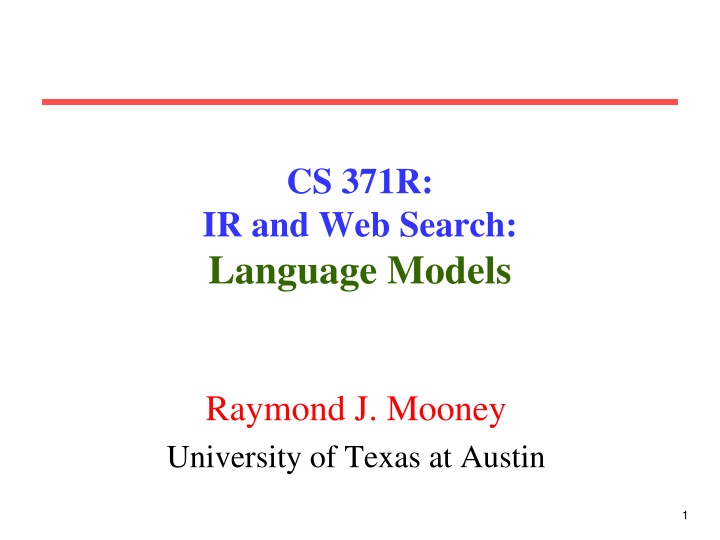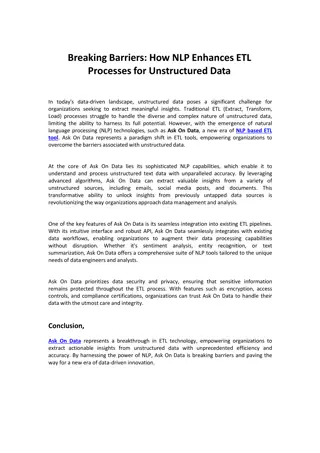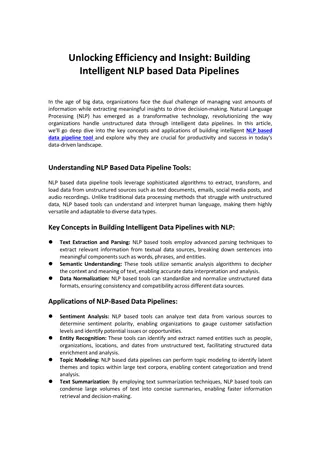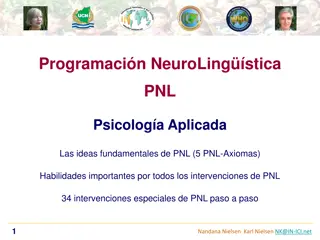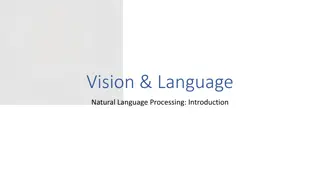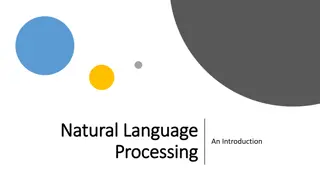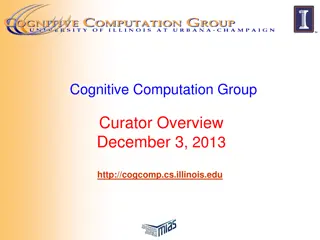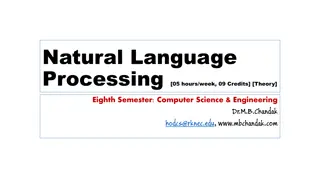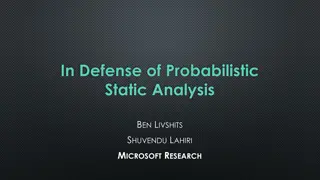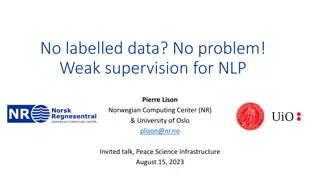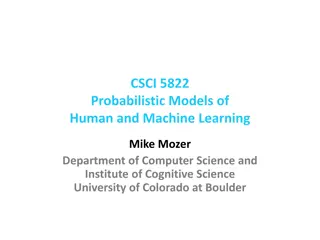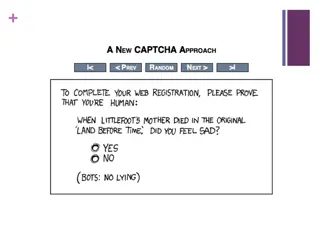Language Models: Probabilistic Models for NLP
Formal grammars provide binary models for language, but probabilistic language models offer a more useful approach by assigning probabilities to sentences. Explore the uses of language models in speech recognition, OCR, machine translation, generation, and spelling correction. Learn about completion prediction and N-gram models, with formulas for estimating probabilities from word sequences. Understand how N-gram conditional probabilities can be estimated from text data to build consistent probabilistic models."
Download Presentation

Please find below an Image/Link to download the presentation.
The content on the website is provided AS IS for your information and personal use only. It may not be sold, licensed, or shared on other websites without obtaining consent from the author.If you encounter any issues during the download, it is possible that the publisher has removed the file from their server.
You are allowed to download the files provided on this website for personal or commercial use, subject to the condition that they are used lawfully. All files are the property of their respective owners.
The content on the website is provided AS IS for your information and personal use only. It may not be sold, licensed, or shared on other websites without obtaining consent from the author.
E N D
Presentation Transcript
CS 371R: IR and Web Search: Language Models Raymond J. Mooney University of Texas at Austin 1
Language Models Formal grammars (e.g. regular, context free) give a hard binary model of the legal sentences in a language. For NLP, a probabilistic model of a language that gives a probability that a string is a member of a language is more useful. To specify a correct probability distribution, the probability of all sentences in a language must sum to 1.
Uses of Language Models Speech recognition I ate a cherry is a more likely sentence than Eye eight uh Jerry OCR & Handwriting recognition More probable sentences are more likely correct readings. Machine translation More likely sentences are probably better translations. Generation More likely sentences are probably better NL generations. Context sensitive spelling correction Their are problems wit this sentence.
Completion Prediction A language model also supports predicting the completion of a sentence. Please turn off your cell _____ Your program does not ______ Predictive text input systems can guess what you are typing and give choices on how to complete it.
N-Gram Models Estimate probability of each word given prior context. P(phone | Please turn off your cell) Number of parameters required grows exponentially with the number of words of prior context. An N-gram model uses only N 1 words of prior context. Unigram: P(phone) Bigram: P(phone | cell) Trigram: P(phone | your cell) The Markov assumption is the presumption that the future behavior of a dynamical system only depends on its recent history. In particular, in a kth-order Markov model, the next state only depends on the k most recent states, therefore an N-gram model is a (N 1)-order Markov model.
N-Gram Model Formulas Word sequences n w 1= ... w w 1 n Chain rule of probability n k = = 2 1 1 1 n n k ( ) ( ) ( | ) ( | )... ( | ) ( | ) P w P w P w w P w w P w w P w w 1 1 2 1 3 1 1 n k = 1 Bigram approximation n = k = n ( ) ( | ) P w P w w 1 1 k k 1 N-gram approximation n = k = 1 N n k k ( ) ( | ) P w P w w + 1 1 k 1
Estimating Probabilities N-gram conditional probabilities can be estimated from raw text based on the relative frequency of word sequences. ( ) C w w = 1 Bigram: ( | ) n w n P w w 1 n n ( ) C 1 n 1 N n n w ( ) C w w = 1 N n n + 1 ( | ) n P w w N-gram: + 1 n 1 N n n ( ) C + 1 To have a consistent probabilistic model, append a unique start (<s>) and end (</s>) symbol to every sentence and treat these as additional words.
Generative Model & MLE An N-gram model can be seen as a probabilistic automata for generating sentences. Initialize sentence with N 1 <s> symbols Until </s> is generated do: Stochastically pick the next word based on the conditional probability of each word given the previous N 1 words. Relative frequency estimates can be proven to be maximum likelihood estimates (MLE) since they maximize the probability that the model M will generate the training corpus T. = argmax ( | ( )) P T M
Example from NLP Textbook P(<s> i want english food </s>) = P(i | <s>) P(want | i) P(english | want) P(food | english) P(</s> | food) = .25 x .33 x .0011 x .5 x .68 = .000031 P(<s> i want chinese food </s>) = P(i | <s>) P(want | i) P(chinese | want) P(food | chinese) P(</s> | food) = .25 x .33 x .0065 x .52 x .68 = .00019
Laplace (Add-One) Smoothing Hallucinate additional training data in which each possible N-gram occurs exactly once and adjust estimates accordingly. w w P n | ( Bigram: + ( ) 1 C w ( C w = 1 ) n n 1 n + ) C w ( V w 1 1 n n n w ( + 1 ) 1 = 1 n n + ( | ) N n P w w N-gram: + 1 n N + 1 n n ) C w V + 1 N where V is the total number of possible (N 1)-grams (i.e. the vocabulary size for a bigram model). Tends to reassign too much mass to unseen events, so can be adjusted to add 0< <1 (normalized by V instead of V).
Advanced Smoothing Many advanced techniques have been developed to improve smoothing for language models. Good-Turing Interpolation Backoff Kneser-Ney Class-based (cluster) N-grams
A Problem for N-Grams: Long Distance Dependencies Many times local context does not provide the most useful predictive clues, which instead are provided by long-distance dependencies. Syntactic dependencies The man next to the large oak tree near the grocery store on the corner istall. The men next to the large oak tree near the grocery store on the corner aretall. Semantic dependencies The bird next to the large oak tree near the grocery store on the corner fliesrapidly. The man next to the large oak tree near the grocery store on the corner talksrapidly. More complex models of language are needed to handle such dependencies.
Summary Language models assign a probability that a sentence is a legal string in a language. They are useful as a component of many NLP systems, such as ASR, OCR, and MT. Simple N-gram models are easy to train on unsupervised corpora and can provide useful estimates of sentence likelihood. MLE gives inaccurate parameters for models trained on sparse data. Smoothing techniques adjust parameter estimates to account for unseen (but not impossible) events.
